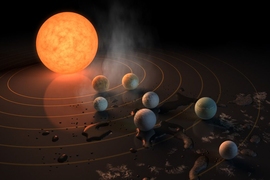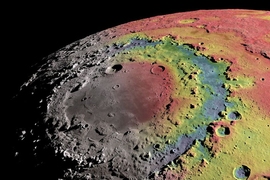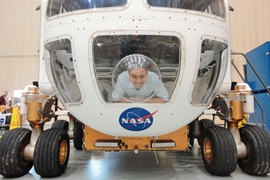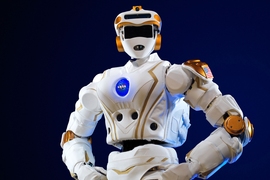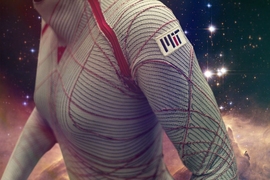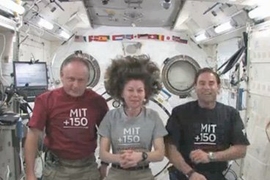Amid a recent resurgence of interest and investment in space, the MIT Media Lab is setting up a new initiative to explore the possibilities. And, its students were the impetus. “It started over last summer, bubbling up as grassroots student interest,” recalls Ariel Ekblaw, a PhD student and research assistant in the lab's Responsive Environments group. “Many of us at the lab share a profound passion for space exploration, and a desire to apply our multidisciplinary interests in this domain — across art, science, engineering, and design. With the dropping costs of space launches, and humanity on the cusp of interplanetary civilization, this is a pivotal moment to join and shape the space industry.”
Ekblaw was the lead organizer, along with Dan “Novysan” Novy, a fellow PhD student at the Media Lab, of Beyond the Cradle: Envisioning a New Space Age, which was held on March 12. The event brought together over 25 speakers — leading space industry figures, sci-fi authors and designers, space science researchers, Hollywood visionaries, and NASA astronauts — to inspire the audience to envision, design, hack, and fabricate our space future. Ekblaw, who will lead the new Space Exploration Initiative, says its research approach aims to drive innovation at the frontiers of space exploration, from the holy grail of life in space to widespread societal involvement in “open space.” She explains, “The opportunity to design our interplanetary lives beckons to us. We hope to bring a new wave of creativity to the New Space Age, pioneering the technologies and tools of engagement that democratize the future of space exploration — bringing moonshots and starshots into the purview of hackers and makers.”
Sense of wonder
“The great thing about space is trying to figure out the problems with a sense of wonder,” Media Lab Director Joi Ito said as he welcomed the 250 Beyond the Cradle attendees (and 300-plus livestream viewers from every continent but Antarctica). Ito added that there are all kinds of questions to raise and investigate. “Space pulls together four quadrants: art, design, science, and engineering, forcing us to work together on a coherent mission.” Space is a “microcosm, or supercosm” of what the Media Lab is about, he said. The new initiative already involves over 40 lab faculty and students, with more expected to take part. And, Ito added, it will also draw in other departments at MIT, which have a storied history of space projects and achievements, especially Aeronautics and Astronautics (AeroAstro) and Earth, Atmospheric and Planetary Sciences (EAPS).
Ito is a principal investigator of the new lab-based initiative, along with Maria Zuber, MIT’s vice president for research and the E. A. Griswold Professor of Geophysics, who has been involved in more than half a dozen NASA planetary missions — including the Gravity Recovery and Interior Laboratory (GRAIL), for which she was the principal investigator. In a video message, Zuber told the audience that the initiative will “accelerate the opening of the spigot of the space frontier. We’re going to need everything from structures to communications to sensors to clothing to entertainment. And we need to be thinking about how we can make use of our presence in space to benefit those who remain on Earth.” That theme was evident in the very title of the March 12 symposium — that space is “beyond the cradle” of civilization as we know it today.
Prospects for the future of space exploration got a boost late last month when an international team including astronomers from MIT announced the discovery of seven Earth-sized planets, relatively close to our solar system — some of which could be habitable for humans. Julien de Wit, a researcher in EAPS, is heading up NASA’s TRAPPIST-1 study of the planets’ atmospheres, and he talked about their findings in his keynote address at Beyond the Cradle. “We started to discover other planets around other stars only 20 years ago, and now we’re already discussing the idea of diving into the atmosphere, searching for signs of habitability and signs of life,” de Wit explained. “We’re aiming for these in the next decade, in the next generation. Beyond the cradle, beyond the Earth, beyond our solar system relate to this new perspective. We have to push harder.”
Ongoing cycle of sci-fi and reality
Other speakers at the March 12 symposium included NASA innovation engineers, astronauts, science fiction’s most creative minds, Hollywood imagineers, and industry leaders in "New Space." At every session, a shared inspiration emerged: science fiction. As Zuber said, “The limits of imagination were reserved for science fiction. But something feels different about space exploration these days. It feels more and more like going to space is a goal rather than a dream.” Astronaut Leland Melvin later agreed, “We’re turning science fiction into science fact.”
"Star Trek" was mentioned numerous times during the day, and J. J. Abrams, director of 2009's "Star Trek" and 2013's "Star Trek Into Darkness," and a former Media Lab Director’s Fellow, sent a video message. He said that when he shot some scenes at the Lawrence Livermore Lab, scientists he met there told him that the "Star Trek" franchise had inspired them to go into space work. “The influence that fantasy and science fiction have on us, and then we on it, is an ongoing cycle.” In fact, “Living a Sci-Fi Space Future” was the title of the plenary address at the event, and Ben Grossmann, visual effects supervisor at virtual reality (VR) content company Magnopus, remembered a time when the two collided. He was working on "Star Trek Into Darkness," trying but not succeeding to make the USS Enterprise arrive at Earth. At the same time, he was watching a live broadcast of the Curiosity rover landing on Mars. “We were almost in tears from our own problems, and then we watched everyone in tears from real-world success.”
Converging worlds
Grossmann then put on VR goggles and walked the audience through a Mission: ISS simulation, navigating the International Space Station. The demonstration prompted this comment from Sheyna Gifford, health and safety officer on the HI-SEAS IV Mars simulation project: “No space opera, no space exploration. Popular culture really does prescribe the boundaries of what the human mind accepts as possible.” Doug Trumbull, a pioneer of visual effects on the big screen, delved into the philosophical questions. “The duality of remote sensing versus actually physically taking our bodies into space are two completely different worlds. But I think they’re converging,” he said. “We can create a telepresence that’s almost indistinguishable from reality.” Fellow panelist, sci-fi author Warren Ellis, agreed, saying that “space exploration is fulfilling something that’s basic in us as humans.”
The very concept of “us as humans” arose during the session, “Frontiers for Life in Space.” In the Q&A period, artist Ayodamola “Ayo” Tanimowo Okunseinde (who’d also appeared on a previous panel) challenged this group to consider humans a million years from now, asking “What sort of evolutionary changes do you foresee for humanity? What sort of genetic modifications can we do now to get us ready for evolution in space?” It was a provocative concept that prompted the panelists to express discomfort. John Min, a PhD student in the Media Lab’s Sculpting Evolution research group, said he has “a lot of difficulty struggling with the ethics and morality of performing genetic engineering on humans. There are many unanswered questions, and we should hold off.” For Alexandra Pontefract, a postdoc in EAPS at MIT, it was a question of “Where do you draw the line?” And moderator Sheyna Gifford said humans are already modifying themselves, “but we’re doing it externally,” designing certain kinds of equipment, for instance.
In another panel discussion at Beyond the Cradle, which addressed the issue of democratizing “open space,” moderator Ariel Waldman referred to the Media Lab’s Disobedience Award: “Disobedience is really needed in space exploration to make what a lot of us are trying to achieve possible. We are seeing some disruption taking place today; I argue, not enough to make space exploration more accessible.” Andy Sellars, who directs the Boston University/MIT Technology and Cyberlaw Clinic reminded the audience of the Outer Space Treaty of 1967: “It’s one of the purest international treaties we have, because no one knew what they could do with space and so no one acted out of self-interest. It’s a really idealistic document.”
Balance between government and commercial ventures
Other sessions at the event looked at designing a space future and its habitats, and simulating space travel. Several people from industry also gave talks, including Andrew Rush of Made in Space, Paul Wooster from SpaceX, and Erika Wagner from Blue Origin. In Wagner’s session, there was a lot of talk about the balance between government-funded projects and commercial ventures. Wagner, who previously studied and worked at MIT, said that everyone is grappling with this issue.
“Federal funding has been establishing the whole beachhead of space. The returns from government dollars have largely been knowledge,” Wagner said. “Now the question is: How do we make business models where things that are made in space have value on Earth and in space? Governments still play a critical role. We look at NASA and others as customers, taking the government book of requirements into account but not having it drive us.” Wagner closed her session by inviting attendees to write on post-it notes what they would like to send to space. One of the notes said simply “Seven astronauts from seven continents.”
Space: the next generation
Throughout the day, many people talked about what space exploration will mean for the children of today and into the future. In the panel on the future of space research, Dava Newman, MIT’s Apollo Professor of Astronautics — just back from a 20-month turn as NASA’s deputy administrator — said the enduring questions for humanity are: "Where do we come from? Are there habitable planets? Where’s the life?" She’s convinced, she said, that within the next decade we’ll probably find life on Mars. “But it’s not just about exploring out. It’s about us as a species, and we want to take every girl and boy with us.”
Some girls and boys from Edwards Middle School in nearby Charlestown, Massachusetts, joined a special session with NASA astronauts Cady Coleman '83, Leland Melvin, and Jeff Hoffman, who’s now a professor of the practice in MIT’s Department of Aeronautics and Astronautics. All three encouraged the young students to study hard and appreciate that their passions and talents could be applied to space projects. Melvin said he’d never imagined he’d be flying in space, while Coleman recalled how she was told that girls don’t do that. The young students’ questions covered the astronauts’ food, their jobs in space, and how they communicated with their families on Earth; zero-gravity toilets, black holes and the astronauts’ underwater training; which space movies are the closest to reality, and why it’s important to send humans to Mars.
When one young student asked if it was scary the first time they went into space, Coleman said “No. You’ve made the decision about whether you want to be there a long time before you’re ever sitting on the top of a rocket.” Hoffman, whose five shuttle missions included the first mission to repair the Hubble Space Telescope in 1993, told the students, “You must have the right personality. There are a lot of things that can go wrong, but there are many things we can do as a crew to fix the problems. We train and train, so I was fully confident that if anything happened, we would do the right thing.”
Melvin said his determination stemmed from something Apollo 16 commander John Young told him: “Once we stop exploring as a civilization, we will falter.” He closed the session by saying that children are the reason space exploration must continue, “because you are our future explorers. You’re going to be the ones saving our planet and finding out the secrets of Mars one day. It’s up to you.”













